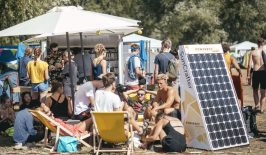Solar power generation has in the last two decades played a central role in in powering off-grid and rural areas, especially in developing countries in the Global South. However, solar power has one clear and major disadvantage, it can only generate electricity during the day. While it is possible to combine photovoltaic cells with batteries to store the electricity that’s produced, these batteries vastly increase the price of a solar panel setup.
The inability to generate electricity at night is a particularly significant drawback when you consider that the demand for electricity peaks often peaks in hours of darkness, when lighting is required.
To solve this issue, a team at Stanford University have been looking into ways to generate a small amount of power from the night sky itself. Their research, which constitutes a major breakthrough in making such technology viable, was recently published in the journal Optics Express.
To understand how their approach functions, it must first be understood how thermoelectric energy generators work. These are semiconductor devices that generate electricity via thermodynamic transfer – essentially the transfer of heat from a hot source into a cold sink. As the heat passes, the difference in electron energy levels between the two materials creates a potential difference which in turn creates an electrical current: a phenomenon known as the Seebeck effect.
By using the Earth, which has been absorbing heat during the day, as the heat source, and the cold of space as the cold sink, the Stanford team have developed a method to generate a small – but functional and useful – amount of power.
Generating Light from Darkness
To demonstrate the potential of their research, they constructed a simple, low cost thermoelectric generator using relatively basic materials. The system, which was placed on a rooftop of their California campus, features aluminum disks that function as a thermal emitter and are adhered to the cold side of a commercial thermoelectric module, facing up to the sky. The other, warm side of the module is heated by the ambient air during the day. When the sky-facing surface radiates that heat out into the cold of space at night (via a passive cooling mechanism known as “radiative sky cooling”), the ensuing temperature difference between the hot side and the cold side can be converted into usable electricity.
During a first prototype test back in 2019, the thermoelectric generator was able to produce around 25 mW per square metre. This is significantly less than a photovoltaic cell functioning in daylight, which can average around 150-200W per square metre, but is enough to power an LED light and other low-energy equipment. Although this amount is rather modest, their prototype was developed for less than 30 USD, making it in many cases a much more feasible solution for low income communities than a solar battery system. As the writers of the study themselves say:
“In off-grid locations throughout the world, this approach of generating light from darkness highlights an entirely new way of maintaining lighting, entirely passively, at night.”
And in a more recent experiment, the researchers were able to increase the power generated to 2W/m2 – two orders of magnitude higher than the previously reported result.
As well as being used as power generation for off-grid communities, this kind of generator could be used to power sensors and smart city technologies elsewhere. Furthermore, the concept could be used to improve on technologies that seek to generate electricity from the waste heat of various sources, such as cooking stoves, computers, industrial processes and even human beings. Currently, much of this heat is simply radiated away, but with sensitive thermoelectric generators, it could be put back to use.
In recent years there has been increasing research into diversifying the situations in which solar panels can generate electricity too, including sun tracking technology and developments that help solar panels generate energy even during rain or in heavy snow.






